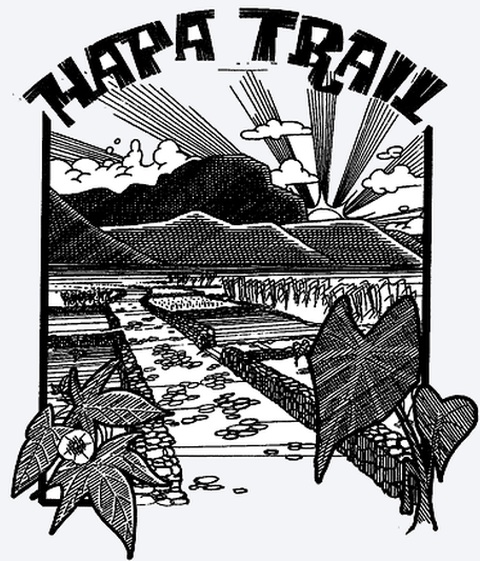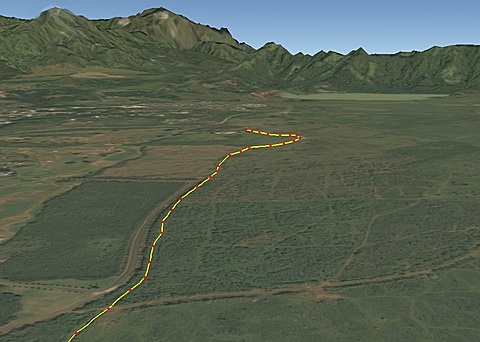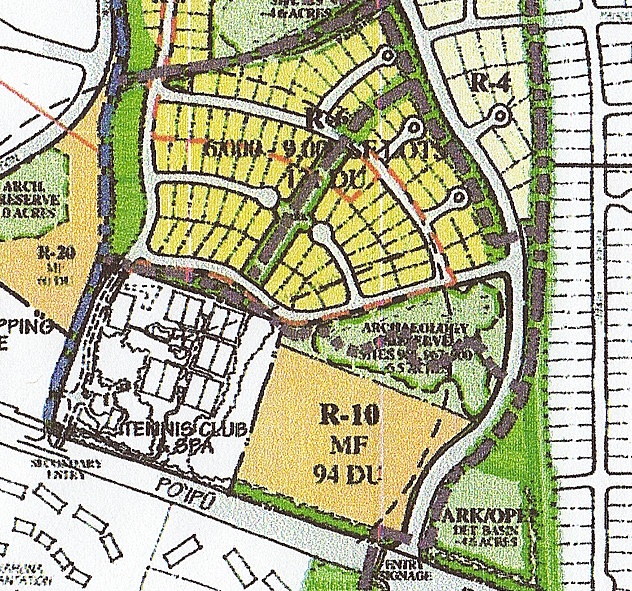SUBJECT: HAWAIIAN SACRED PLACE
SOURCE: JERI DIPIETRO ofstone@aol.com
POSTED: 12 NOVEMBER 2008 - 6:00pm HST
Hapa Trail Meeting & Walk

image above: Detail of flyer forr Hapa Trail Walk. Click for whole PDF file to reproduce and distribute
[Editior's Note: It is our opinion that what is important here is to associate the Hapa Trail with the archaeological record on the site and realize its importance to the past and future sustainability of the southside. This path should not be considered an amenity to a development with a cutesy historic past.It was the backbone of a pedestrian community.] by Jeri Di Pietro on 11 November 2008
Koloa Communuty Asocciation Meeting WHERE: This Hapa Trail Walk will be an opportunity for Koloa Community Association Board members, interested residents, council people, planners and historians to learn more about the proposed restoration and alignment issues relating to historic Hapa Trail. Hapa Trail Walk WHERE: Koloa Community Association and The Hapa Restoration Committee will host a Hapa Trail Walk on Saturday, November 22 at 8am, meeting at the St. This willbe a informative trip regarding zoning, history, archaeology & restoration of the Hapa Trail. We will be stopping along the way to learn about the prehistoric agricultural uses, zoning history, pedestrian and bicycle easement. This will be a round trip walk, with refreshments provided at the south end of Hapa at Poipu Road. We will walk back up Hapa Trail to St. Raphael's church. Approximately 2 1/2 hours round trip. CONTACT: Jeri Di Pietro pnone: 808-651-1332 email: ofstone@aol.com koloacommunityassociation.org |
SUBJECT: HAWAIIAN SACRED PLACE
SOURCE: JERI DIPIETRO ofstone@aol.com
POSTED: 22 OCTOBER 2008 - 12:00pm HST
Hapa Trail "Restoration"

image above: GoogleEarth view looking north at Hapa Trail, south of Koloa, and north of Poipu
by Jeri Di Pietro on 17 October 2008 Please join the Hapa Trail Restoration Committee on Saturday morning, November 1, 2008 at 8am for a Hapa Trail Walk and Talk. |
SUBJECT: HAWAIIAN SACRED PLACE
SOURCE: JUAN WILSON juanwilson@mac.com
POSTED: 19 AUGUST 2008 - 9:00am HST
Waikomo Ahupuaa Preservation

image above:1999 NOAA aerial photograph of area of proposed Knudsen Trust development of Village at Poipu
by Juan Wilson on 19 August 2008 - Revision 4.0 080828b I have been watching Poipu and Koloa since my first visit in 1971-72, and I have to say, the area has been Californicated to the degree that it is no longer part of Hawaii or Kauai. There are remnants of what used to be a community, but that’s all they are... remnants. And ever since that time in the early 70's plans has been afoot to develop vast tracts of the area. As beautiful as Poipu Beach is, the shoreline is so overpopulated that the next wave of completed projects will make it unusable. The current population will have tripled by the time all the plans currently in the pipeline are realized. The Eric Knudsen Trust is currently planning a large scale residential development mauka of Poipu Road, euphemistically called “The Village at Poipu”. This project is coming in several phases and will eventually stretch from Koloa Town down to Poipu. It’s all cul-de-sacs and high priced sprawl. Phase one is situated on a portion of the south end of a 123 acre parcel of land (TMK 42801019) that the county recognizes as the property of the Knudsen Trust. It will include 65 residential single family lots. Note in plan below that the area marked R-10 is the highest residential density and is on Poipu Road in the middle of an area of particular archeological interest. The area of this development and the area surrounding it is one of the more important archeological sites in the state of Hawaii. It is in the midst of about 500 acres that separate the old Koloa sugar plantation area from the resort development to the west. This area between Poipu Beach and the foothills of the mountains at Waikomo Reservoir was never developed. Right now this project is on track. Even though the permit for the project ran out in 2004, the county has just renewed the permit without much discussion. The focus of obfuscation now is a discussion of Hapa Trail. This feature is an amenity of the development of this property that goes back to promises made in the 1970’s. What it boils down to is a walking path from Koloa Town down to Poipu through
the suburban sprawl. Although county property maps show Knudsen Trust as the owner, it should actually be the State of Hawaii to the various properties on this large site. The state received the territorial lands which had been crown lands from the Kingdom of Hawaii. The Hawaiian Supreme Court has recently determined that the State has no right to sell or transfer crown lands that it has obtained, and it is in fact merely a caretaker of Hawaiian lands until they can be given back to the Hawaiian people. I’ve had enough from the speculators, greedy land sharks, the lawyers, and county gangsters that are hell bent on destroying Kauai. Mainland money and interests are behind much of the rape and pillaging, but the destruction could not happen without the aid and support by greedy people right here on Kauai.
|

image above: Detail oPhase One of Draft master Plan for the Village at Poipu by PBR Associates, Honolulu, HI
SUBJECT: HAWAIIAN SACRED PLACE
SOURCE: JUAN WILSON juanwilson@mac.com
POSTED: 28 AUGUST 2008 - 11:00am HST
Who Owns the Land in Koloa?
by Juan Wilson on 28 August 2008 The following begins to illustrate how resistant Hawaiians in Koloa were to the operation of the plantation operators. The Kingdom of Hawaii was not happy not selling land to foreigners. It did lease land for agricultural use, as in Koloa. The reference book( Koloa Plantation 1835 - 1935 by Alexander, Arthur (1937). Honolulu, HI) details the history of plantations on the southside, and Wikipedia shows how quitclaims might may have been used to gain "title" to lands without proper assurances.
|
Wikipedia History of Koloa Sugar Plantation
|
Wikipedia Definition of Quitclaim Deed A quitclaim deed is a term used to describe a document by which a person (the "grantor") disclaims any interest the grantor may have in a piece of real property and passes that claim to another person (the grantee). A quitclaim deed neither warrants nor professes that the grantor's claim is actually valid. By contrast, the deeds normally used for real estate sales (called grant deeds or warranty deeds,
depending on the jurisdiction) contain guarantees from the grantor to the grantee that the title is clear.The exact nature of the warranties vary from jurisdiction to jurisdiction. Quitclaim deeds are sometimes used for transfers between family members, gifts, placing personal property into a business entity, or to eliminate clouds on title, or in other special or unusual circumstances. It fails to meet all five traditional tests of a true
deed found in common law. Instead, it is considered to be an instrument of estoppel, which means it estops or prevents the grantor of the quitclaim deed from later claiming that he or she has an interest in the property. Title companies may be unwilling to issue title insurance based on a quitclaim deed; thus, quitclaim deed holders may have to obtain further proof that a bona fide sale occurred or institute a quiet title action in a court to obtain clear
title.
|
see also:
Island Breath: Save Poipu 8/3/05
Island Breath: Pall Over Poipu 8/1/05
Island Breath: Haena Burial Site 6/9/08